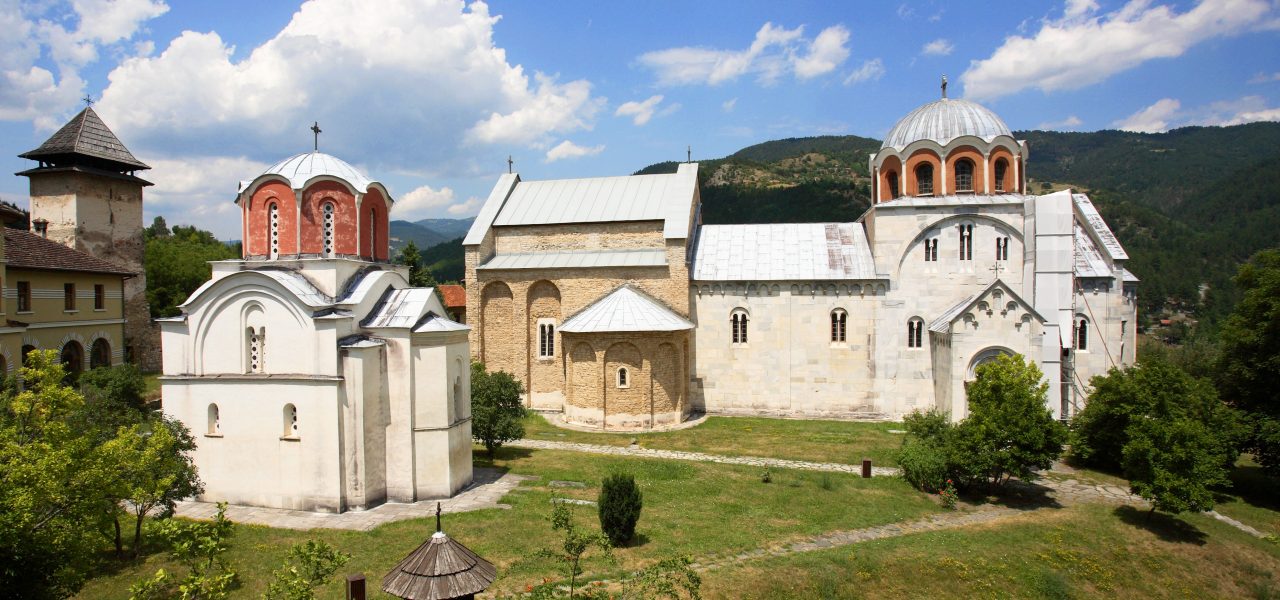INTRODUCTION
The monastery is one of the most beautiful Serbian monasteries, because of the refined architecture of the Byzantine-Raska school and of the beautiful landscapes in which it is located.
HISTORY
Studenica was built by Stefan Nemanja from 1183 to 1196.
From 1206 until the middle of the second decade of the 13th century, Saint Sava resided in Studenica as an elder Abbot in the rank of Archimandrite. Under Sava’s tutelage, the Studenica Monastery became the cultural, spiritual and medical center of medieval Serbia.
There used to be 14 churches and chapels (smaller churches) in the Monastery complex itself, of which three are preserved today. All are liturgically active preserved chapels.
While the turkish rule period in the 17th century it was very difficult for Studenica. At the beginning of their rule the turks first melted the lead roof structure into ammunition. It was looted after the great Austrian-Turkish war (1683–1699) after the withdrawal of the Austrian army. The Monastery itself suffered until the first serbian uprising. The turks burned the Monastery, but a part of the monks took refuge in the Vraćevšnica Monastery and took with them the relics of the monk Simon with them. The relics were transferred from Vraćevšnica to the Kalenić Monastery and finally returned to Studenica in 1839.
In addition to the burning, the monastery church underwent an unprofessional renovation in 1846, when painters applied a new layer of plaster over old frescoes and painted new frescoes. Over a hundred years later, in 1951, during the first professional restoration work, this layer had been removed. At that time, the founder’s inscription of Saint Sava was rediscovered.
UNESCO placed Studenica on the List of the World Cultural Heritage, in 1986.
ARCHITECTURE AND FURNITURE
Within the Studenica Monastery compound the most important and best know is the church devoted to the Mother of God Evergetida – Church of our Lady, which is a crypt of Stefan Nemanja. It was built in the period between 1183-1196/7. Byzantine view of the world and Romanesque elements were brought together in a unique manner in this major monument of Nemanja. The exterior is in the Romanesque spirit, while its paintings bear the Byzantine characteristics. The Romanesque elements are decorative façade finishing. The highest levels of the façade are done in characteristic arcade shaped friezes on consoles cut in stone. Monumental portals are characteristic as are the windows richly decorated by sculpture decorations, magnificent wet portal and particularly triforium on the altar apses, which dominates the eastern part of the church thanks to its exquisitely carved plant motive decorum and phantasmagoric creatures, as a winged dragon and basiliscus, with a long snake tale. Sculptural ornament and the form of that triforium served as a model almost literally replicated on the altar triforium of the Church in Dečani.
The Romanesque decoration of St. Marry’s church in Studenica represents one of the richest programmatic and stylistic creations in the Serbian Medieval art.
The Trasury of Studenica will introduce you tot he ring of the First-crowned, religious artefacts, beautifil paintings and frescoes, books and other very important relics of Serbian medieval church and state.
OPENING HOURS
Summer (April 1 – October 31)
7.00am – 7.00pm
Winter (November 1 – March 31)
8.00am – 4.00pm
On Sundays and Feast days:
Matins at 6.30am,
Holy Liturgy at 8.00am
other days:
Matins at 5.30am,
Holy Liturgy at 6.45am
Vespers in the winter period starts at 5.00pm and in the summer time at 6.00pm.
CONTACT
Studenica Monastery
Phone: + 381 (0) 36 543 6050 and + 381 (0) 64 464 7492
konakstudenica@gmail.com
www.manastirstudenica.rs
ENTRANCE FEES & GUIDED TOURS
Adults: EUR 2,00
Guided Tours on request.
TOURIST INFORMATION OFFICE
Tourism and Sport
Organisation Raška
Nemanjina 1, 36350 Raška
Phone: +381 36 738 670 and +381 36 736 085
office@raska-turizam.rs
www.raska-turizam.rs


